(Spanish translation to follow/traducción en español abajo)
A kaleidoscope of vegetables and flowers, each symbolizing an initiative connected with seed saving, blossoms under shifting seasons. The garden includes the Hiawatha Belt Arbor, pollinator friendly flowers, the Akwesasne Seed Rematriation Garden and new partnerships.
By Amy Wu

Tucked within a farmscape of cover crops is a two acre piece of land that serves as home to a tapestry of vegetables and flowers. On this late summer day butterflies playfully chase one another and bumble bees draw figure eights in flight. A sunflower with its plate-sized head nods hello and good morning to visitors.
The Native American Seed Sanctuary, a partnership between the Mohawk Akwesasne community, Seedshed (a nonprofit that focuses on seed justice) and the Farm Hub was launched in 2015 with a purpose of rematriating saved seed varieties back to the Mohawk Nation community of Akwesasne, and preserving the agricultural and cultural heritage of the Native American people.
In 2020 the initiative celebrated its fifth anniversary with several milestones, including a new name. The Native American Seed Sanctuary was renamed Kanenhaká:ion Tsiakwaiénthos: the Akwesasne Seed Rematriation Garden to further honor its roots.
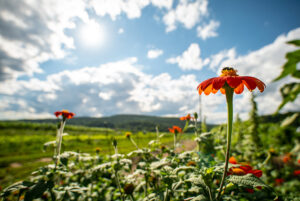
New developments this year included a field of Bear Paw Popcorn which, along with beans and squash, were returned to the Akwesasne Freedom School and a Mother Earth Garden shaped in a woman’s figure created to teach youth about the Mohawk creation story, food, and farming.
Mary Arquette, who works through the Akwesasne Task Force on the Environment supporting the gardens at the Akwesasne Freedom School, says: “I grew up in the garden. We grow our food and seeds at home to share with the community. To keep our language, our seeds, and our foods alive is important because without them we no longer exist as a people. Planting these seeds is the way we live.”
In addition, the initiative has expanded to include new partnerships such as the Palestine Heirloom Seed Library
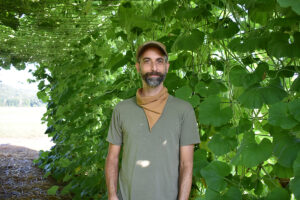
The vegetables and plants in the garden represent the new partnerships. And while each comes with its unique story, these organizations all share the common value of saving seeds to support seed justice in a specific community.
Ken Greene, the founder of Seedshed, says: “We believe that seeds, as life-giving beings, are our caregivers. In return, we care for seeds in a way that nurtures the relationships among humans, the living soil, the elements, and diverse members of our natural ecosystem. Everything grown here is cared for under the guidance of leaders from each seed’s home community. And all of the seeds harvested are rematriated to the hands and lands of our partnering communities.”

There are features within the garden that hold special meaning for members of the Mohawk Akwesasne community.
Kenny Perkins, Akwesasne Seed Keeper for Seedshed, points to the Hiawatha Belt Arbor that divides the produce represented by partners and that of the Akwesasne.
“The Hiawatha Belt Arbor represents the reintroduction of the old seeds to their ancient homelands. An archway to say you are home and a reminder to be at peace and of good mind when you are with the seeds,”
Kenny Perkins, the Akwesasne Seed Keeper for Seedshed.
Join us on a mini-tour of the Seed Gardens and Akwesasne Seed Rematriation Garden:
To watch our short documentary “Seeds of Hope” that tells the story of this special initiative click here.
Here below, individuals from the various partner organizations share their passion and their connection with the Garden.
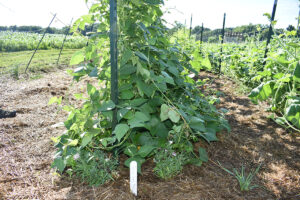
“Xkànim, the Lenape word for seed, represents the pathway for the return of the Lenape to ancestral lands. The corn and beans being grown in partnership with Seedshed represent the Lenape Center’s mission: to continue Lenapehoking, the Lenape homeland, to push back against erasure and seed the ground with Lenape consciousness for future generations,” Joe Baker, The Lenape Center
Lenape Beans, Sehsapsing Corn, Hannah Freeman Bean, Purple Kingsessing Bean, and Blue Shackamaxon Bean
Palestine Heirloom Seed Library
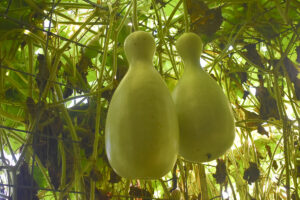
“Yakteen is a magical being, a beloved Palestinian food. Yakteen will take over your world, transforming it into an ocean of green vines, broad velvet leaves, lacy white flowers, and pale green bottle shaped fruits that can be used for food, healing, and making bowls. When we plant seed in the ground say this prayer “may we eat and may we feed others.” This partnership allows us to share these seeds, and our cultural dishes, with Palestinians living in the United States as well as inspire more people to fall in love with Yakteen,” Vivien Sansour, Palestine Heirloom Seed Library
Yakteen edible gourds.
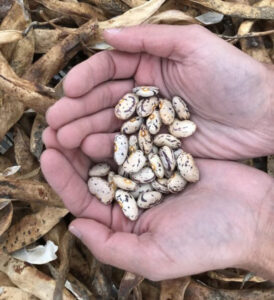
Morton Seed Library (Rhinecliff)
“These are our 100-year-old beans- from my grandfather, Francesco Sammataro, who immigrated to the United States in 1920 from Tusa on the coast of Sicily. They have been passed down for generations. Including these beans in the seed garden and the Morton Seed Library is a wonderful way to honor my grandfather’s and mother’s memory and provide continuity to this story,” Paul Siebold, Rhinebeck Community Garden
Sammataro Bean

“Seeds are living links of a historical chain, anchoring us to a larger community, connecting us to our ancestors, rooting us firmly in the present, giving us a sense of identity, belonging, and purpose. Seeds, and the soil in which they are enveloped, form the foundation of our foodshed. Our regional seed partnership supports community-based food solutions by preserving the biodiversity that reflects the rich tapestry of NYC foodways. Accessing land through this model offers a regional solution to a challenge faced by urban and rural growers alike,” Jackie Pilati, Reclaim Seed NYC
Calico beans, resina calendula, and buttercrunch bib lettuce
UN CALEIDOSCOPIO DE FLORES Y VEGETALES FLORECE TRAS EL CAMBIO DE ESTACIÓN Y CADA UNA SIMBOLIZA UNA INICIATIVA VINCULADA A LA PRESERVACIÓN DE SEMILLAS. EL JARDÍN INCLUYE EL ARCO DEL CINTURÓN DE HIAWATHA, FLORES AMIGAS DE LOS POLINIZADORES, AKWESASNE SEED REMATRIATION GARDEN Y NUEVAS COLABORACIONES.
Por Amy Wu

Inserto dentro de un agropaisaje de cultivos de cobertura, hay un pedazo de tierra de dos acres que alberga un entramado de flores y vegetales. Este día de verano tardío, las mariposas se persiguen entre sí juguetonamente y los abejorros dibujan el número ocho mientras vuelan. Un girasol, con su cabeza del tamaño de un plato, se inclina a saludar y desearle un buen día a los visitantes.
El santuario de semillas nativoamericanas, Native American Seed Sanctuary, es una colaboración entre la comunidad mohawk de Akwesasne, Seedshed (una sin fines de lucro enfocada en la justicia de semillas) y Farm Hub. El santuario fue fundado en el 2015 con el propósito de rematriar variedades de semillas recolectadas a la comunidad de la Nación Mohawk de Akwesasne y preservar la herencia agrícola y cultural de los pueblos nativoamericanos.
En el 2020 esta iniciativa celebró su quinto aniversario con varios logros importantes, incluso un nombre nuevo. Native American Seed Sanctuary fue renombrado Kanenhaká:ion Tsiakwaiénthos: Akwesasne Seed Rematriation Garden para seguir honrando sus raíces.

Entre las novedades de este año, incluimos una parcela de maíz de palomitas “bear paw” que, junto con frijoles y calabacín, fueron regresados a la escuela Akwesasne Freedom School y el jardín Mother Earth Garden. Este último es un jardín cuya forma se asemeja a la figura de una mujer y fue creado para enseñarle a la juventud sobre la historia mohawk de la creación, los alimentos y la agricultura.
Mary Arquette, que trabaja en la comisión ambiental —Akwesasne Task Force on the Environment— apoyando los jardines de Akwesasne Freedom School, dice: “Yo me crié en el jardín. Cultivamos nuestra comida y semillas en casa para compartirlas con la comunidad. Es importante mantener vivo nuestro idioma, nuestras semillas y nuestros alimentos, ya que sin ellos ya no existiríamos como pueblo. Sembrar estas semillas es nuestro modo de vida”.
Además, la iniciativa se ha extendido para incluir nuevas colaboraciones como con Palestine Heirloom Seed Library.

Las plantas y los vegetales del jardín representan las nuevas colaboraciones. Y aunque cada una tiene su historia particular, todas estas organizaciones comparten el objetivo común de preservar semillas para apoyar la justicia de semillas en una comunidad específica.
Ken Greene, el fundador de Seedshed, dice: “Creemos que las semillas, como entes que dan vida, son nuestras cuidadoras. En cambio, nosotros cuidamos las semillas de manera que nutran las relaciones entre los humanos, el suelo viviente, los elementos y los diversos miembros de nuestro ecosistema natural. Todo lo que crece aquí se cuida bajo la guía de líderes de cada una de las comunidades que son hogar de estas semillas. Asimismo, todas las semillas cosechadas son rematriadas a las manos y las tierras de las comunidades con las que colaboramos”.

Hay elementos dentro del jardín que guardan un significado especial para los miembros de la comunidad mohawk de Akwesasne.
Kenny Perkins, preservadora de semillas de Akwesasne en Seedshed, señala el arco del cinturón de Hiawatha que divide los cultivos que representan a los colaboradores de aquellos de Akwesasne.
“El arco del cinturón de Hiawatha representa la reintroducción de las semillas ancestrales a sus antiguos territorios natales. El arco es un anuncio de que estás en casa y un recordatorio para estar en paz y tener buenas intenciones cuando estás con las semillas,”
Kenny Perkins la preservadora de semillas de Akwesasne en Seedshed.
Acompáñenos en un pequeño recorrido de los jardines de semillas y Akwesasne Seed Rematriation Garden:
Para ver nuestro corto documental, “Seeds of Hope”, que cuenta la historia de esta iniciativa especial, haga clic aquí.
Aquí abajo, individuos de las distintas organizaciones colaboradoras comparten sus pasiones y sus vínculos con el jardín.

“Xkànim, la palabra lenape para semillas, representa el camino para el regreso de los lenape a sus territorios ancestrales. El maíz y los frijoles que se cultivan en colaboración con Seedshed representan la misión de Lenape Center: continuar Lenapehoking, el territorio natal de los lenape, para luchar contra el borrado cultural y sembrar la tierra con la conciencia lenape para el disfrute de las futuras generaciones”, Joe Baker, The Lenape Center
Frijoles lenape, maíz Sehsapsing, fríjol Hannah Freeman, frijol morado Kingsessing y frijol azul Shackamaxon
Palestine Heirloom Seed Library

“El yakteen es un ente mágico, un alimento palestino muy querido. El yakteen se apoderará de su mundo, transformándolo en un océano de ramas verdes, amplias hojas aterciopeladas, flores blancas y delicadas, así como frutos verde pálido en forma de botella que pueden usarse como alimento, para la sanación y para hacer cuencos. Cuando sembramos la semilla en el suelo recitamos esta oración “que podamos comer y que podamos alimentar a otros”. Esta colaboración nos permite compartir estas semillas y nuestros platos tradicionales con palestinos que viven en los Estados Unidos, así como inspirar a más personas a enamorarse del yakteen”, Vivien Sansour, Palestine Heirloom Seed Library

Morton Seed Library (Rhinecliff)
“Estos son nuestros frijoles centenarios – de mi abuelo, Francesco Sammataro, que inmigró a los Estados Unidos en 1920 de Tusa en la costa siciliana. Se han pasado de generación en generación. La inclusión de estos frijoles en el jardín de semillas y en Morton Seed Library es una forma maravillosa de honrar la memoria de mi abuelo y mi madre, así como de darle continuidad a esta historia”, Paul Siebold, Rhinebeck Community Garden
Frijol Sammataro

“Las semillas son enlaces vivientes de una cadena histórica, que nos anclan a una comunidad más grande, que nos vinculan a nuestros ancestros, que nos enraízan firmemente en el presente, dándonos un sentido de identidad, pertenencia y propósito. Las semillas, y el suelo que las envuelve, forman los cimientos de nuestra cuenca alimentaria. Nuestras colaboraciones regionales en torno a las semillas apoyan soluciones alimentarias de base comunitaria al preservar la biodiversidad que refleja el abundante entramado de tradiciones culinarias de la ciudad de Nueva York. Acceder a la tierra a través de este modelo nos ofrece una solución regional a un desafío que enfrentan tanto los agricultores urbanos como los rurales”, Jackie Pilati, Reclaim Seed NYC
Frijoles calicó, resina caléndula y lechuga mantecosa tipo Bibb
